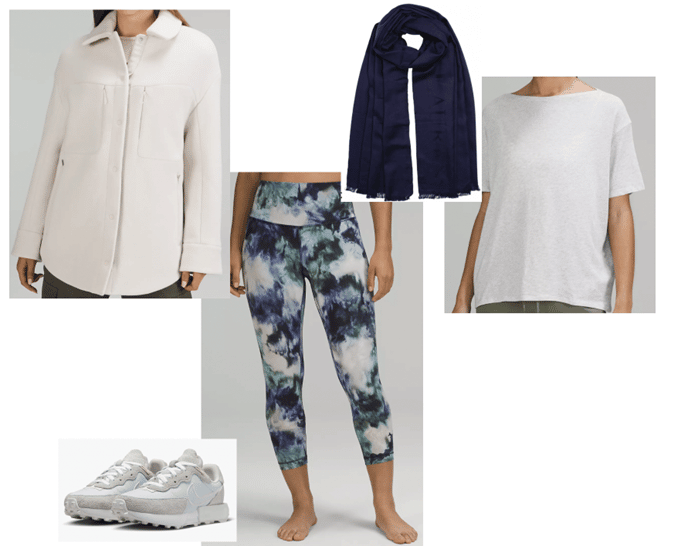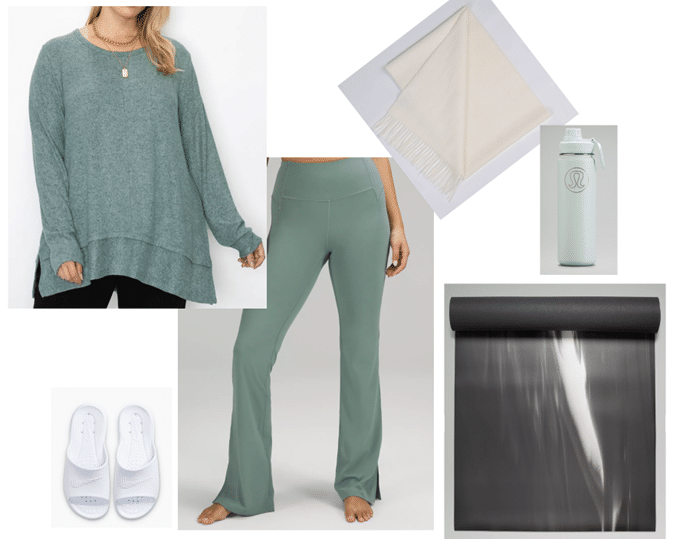What To Wear at a Retreat – Outfits to Inspire You

Sometimes we simply need to get away from it all and take some time for ourselves. Retreats and spas are great ways to unwind and practice mindfulness.
Are you heading out to a retreat? Will this be your first retreat? A retreat can be anything from a weekend getaway at a luxury spa to a week-long silent meditation in a remote forest.
Although you’re not going to a fashion show and don’t need to dress to the nines, you still need to wear appropriate clothing while you are there.
Here are a few outfit ideas that are appropriate for retreats and that may inspire you. The items shown are listed below the outfit but look in your closet to see if you have anything similar that you can use to put your own outfits together.
Read more: What to Wear on a Boat – Outfits to Inspire You.
Dress for Comfort
First of all, let’s remember that the main thing to consider when putting together your clothing for a retreat is comfort. Depending on what type of retreat you are going to you may be doing some yoga or other type of exercise and you may be doing some meditation that is typically done sitting on the ground or on a small cushion. This requires clothes that have stretch and don’t dig into your skin.
What to Bring
Bring clothing and essentials depending on the climate of the location of your retreat.
Make sure you ask the retreat if they provide things like towels or other accessories needed for your stay.
Tie-Dye Dreams

These fun tie-dye cropped leggings from Lululemon look great with a white t-shirt and navy accessories. Remember to purchase your leggings in the proper size, even size up if necessary. Nothing is more uncomfortable than leggings that are too small.
iniber High Waisted Yoga Pants with Pockets
Love Curved-Hem Crewneck T-Shirt
Always Effortless Classic-Fit Jacket
Soft Moss

Matching your top and bottom creates a softer look and may make you look taller. Moss green is a relaxing and soothing color and is great for retreats or yoga practices. Here the top is heathered and the bottom is solid, creating a textured look.
Wunder Under SmoothCover High-Rise Bootcut Pant 34″
Under Armor Twist Tech V-Neck Short-Sleeve Top
Back to Life Sport Bottle 24oz
The 5mm Mat Made With FSC-Certified Rubber
Alpaca Collections Eco Boucle Baby Alpaca & Silk Scarf
Casual Black & Gray

You can never go wrong with a black & gray outfit. Heather gray is synonymous with relaxed and casual. Ruanas (or open-front ponchos) look great, are super easy to wear, and are an excellent choice for a retreat.
ID Ideology Plus Size Essentials Long Sleeve T-Shirt, Created for Macy’s
Clarks Cloudsteppers Breeze Bali Slip-On Shoe
Daily Multi-Pocket Tote Bag 20L
What Should You Avoid Wearing at a Retreat?
Packing for a retreat isn’t about impressing anyone; it’s about creating ease for yourself and respect for the shared space. Here are a few things best left out of your retreat bag:
Restrictive or Tight Clothing
Whether you’re sitting cross-legged on a cushion, stretching into a yoga pose, or simply lounging in a group circle, tight waistbands or structured fabrics can become uncomfortable quickly. Choose pieces that move with you, not against you. Even jeans, unless they’re ultra-soft, can start to feel constrictive during long periods of stillness or movement.
Noisy Fabrics
That stylish windbreaker or swishy track pant may work at home, but in a quiet meditation room, every rustle can be distracting. Opt for soft, silent materials like cotton, modal, bamboo, or jersey that won’t draw attention every time you shift positions.
Strong Perfumes or Fragrances
Many retreats, especially those focused on mindfulness or healing, have fragrance-free policies. Even light perfumes or scented lotions can be overwhelming in shared, enclosed spaces and may trigger allergies or sensitivities in others. It’s best to stick with unscented skincare and hair products while you’re there.
Read more: 100% Fragrance-Free Hair Product Brands for Women Over 50
Flashy Jewelry or Accessories
Dangling earrings or clunky bangles can be noisy and visually out of place in a setting designed for calm and presence. A simple pair of studs or a meaningful pendant may be fine, but leave the statement pieces at home. Minimalism tends to match the tone of most retreat environments.
Busy Patterns or Loud Logos
While there’s no need to dress in head-to-toe neutrals, overly bold prints or large brand logos can feel jarring in a group aiming for inner quiet. Choose soft colors and gentle patterns that won’t dominate the room.
High Heels or Hard-Sole Shoes
You’ll likely be walking between sessions or practicing grounding activities like walking meditation. Loud, clunky shoes can be distracting and uncomfortable. Bring slip-on sneakers, soft-soled flats, or supportive sandals instead.
Keeping your wardrobe simple and mindful not only enhances your own comfort, but it also supports the peaceful atmosphere your fellow retreat-goers are seeking.
Read more: Casual Outfits for Women Over 60 That Don’t Sacrifice Style.
Let’s Have a Conversation:
Are you going to a retreat soon? What type of retreat do you prefer? What will you be packing in your bag? Tell us about it in the comments below.
Read More



